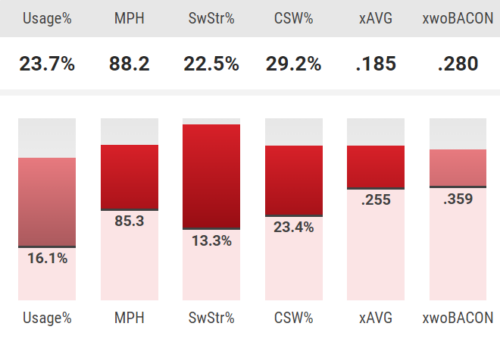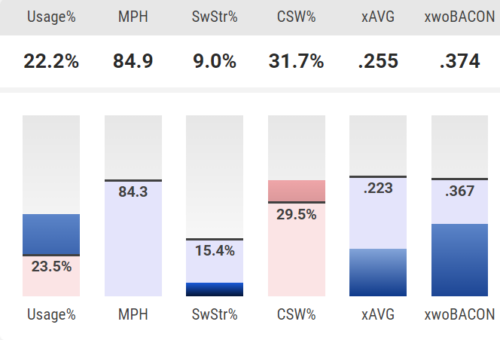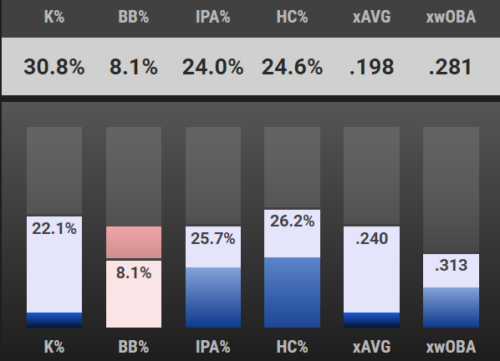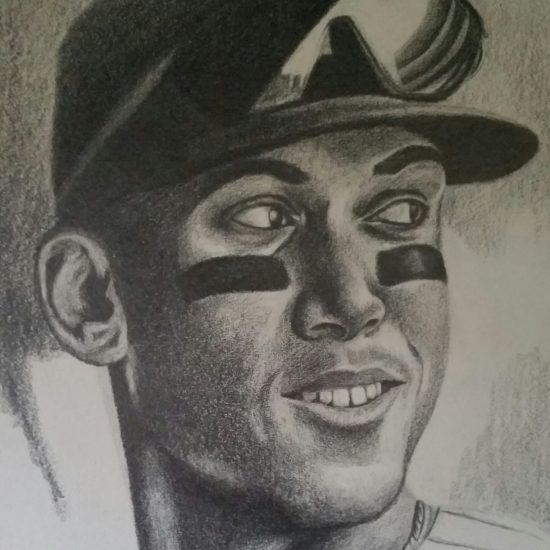Granted, four years is an eternity nowadays with how quickly rosters turn over. Still, you can’t deny how totally different this Red Sox roster will look compared to the one that won it all in 2018. Xander Bogaerts (SD), J.D. Martinez (LAD), and Nathan Eovaldi (TEX) highlight the latest departures. Last year, Boston finished at the bottom of a very competitive AL East, which now boasts an Orioles squad that looks to be very much on the upswing. It’s hard to argue against a similar outcome next year. But for fantasy purposes, this could be an interesting roster.
Boston’s rotation sorely missed their once indomitable but now enigmatic ace, Chris Sale. After undergoing Tommy John surgery in 2020, the lefty posted a 3.16 ERA and 1.34 WHIP through nine starts the following season. But last year a stress fracture in his right rib sidelined him until mid-July before a broken right wrist sustained during a bicycle ride gone awry ended his season. Who knows what we’ll see from the former Southsider. But his career 3.03 ERA and 1.04 WHIP (1678 IP) will certainly make the 33-year-old veteran a person of interest in the spring.
Signed to a one-year deal, Corey Kluber joins a rotation that is missing Rich Hill (124.1 IP and 26 starts), Michael Wacha (127.1 IP and 23 starts), and Nathan Eovaldi (109.1 IP and 20 starts). Kluber is far removed from his heyday as a two-time Cy-Young award winner with Cleveland. And before last year, he hadn’t pitched more than 80 innings since 2018. But he still has excellent control: his 3.0% walk rate was the lowest among qualified starters last season.
Another oft-injured left-hander is lurking in the Boston rotation in James Paxton. The Big Maple last appeared with the Mariners in 2021, where he made one start before needing Tommy John surgery. It’s been a long time since we’ve seen Paxton pitch but he did post a 3.79 ERA, 1.19 WHIP, and a K rate over 30% across 311 IP during the 2018-19 seasons with the Mariners and Yankees. A grade-2 lat strain during a rehab start in late August ended his season.
Tanner Houck only made four starts before settling in the back end of the pen where he was much more effective and picked up eight saves, but that won’t happen again barring something unexpected to new addition Kenley Jansen. After recovering from surgery to correct a back injury that ended his season in August, the righty is preparing to start the 2023 season in the rotation. However, the team did inform him that he might be shifted to the pen. Houck did have a 30% K rate through 13 starts in 2021, but he has yet to throw over 90 pitches in an outing and has struggled against lefties.
Similar to Houck, Garrett Whitlock made a few starts before ending the season in the pen where he was also very effective. However, Whitlock (17.7% K-BB%) was significantly more efficient than Houck (8.7% K-BB%) as a starter. Of the two, Whitlock seems to have a more secure spot in the rotation. But keep in mind, this rotation per roster resource is headed by Sale, Paxton, Corey Kluber, Nick Pivetta, and Whitlock, who has yet to reach 80 IP in a year. Safe to say, there should be plenty of starts to go around.
After letting J.D. Martinez walk, the Red Sox replaced him with Justin Turner on a one-year deal. Fenway Park isn’t a bad place for righties, so he might provide some value as a CI in deep formats with a return to his former self, a batter who posted a .877 OPS from 2014-21 while with the Dodgers.
Addressing their thin outfield, Boston splurged on 29-year-old NPB star Masataka Yoshida signing him for a five-year deal worth $90 M. I won’t go into detail about Yoshida here. But as Justin Choi of FanGraphs points out, he’s shown terrific K/BB during his career in Japan. Projections seem to vary the most about his power. But the lefty has shown a good amount of it, peaking with 29 home runs in 2019. Last year, he posted a career-best 1.007 OPS with the Orix Buffaloes and is a career .326 hitter (3251 PA).
Sleepers
2022 stats (95 PA): .197 AVG, 11 R, 5 HR, 12 RBI, 1 SB
In December, the Red Sox released Eric Hosmer so the road is now officially wide open for their highly touted first baseman. If you follow prospects, the 22-year-old lefty is, of course, no secret. Selected 26th overall in the 2018 draft, Casas signed a bonus worth just over $2.5 M and has been a prodigy. In 2017, he won the MVP of the 18-and-under World Baseball Cup. That year, he also won the Richard W. Case Player of the Year Award presented by USA Baseball.
In 2019, he began his pro career with a bang by being named the Red Sox’s Minor League Offensive Player of the Year Award. He also became the first Red Sox minor leaguer to hit 20 home runs in a year before turning 20 since Xander Bogaerts in 2012. So his power has been impressive from the get-go. Two years later, he took home a silver medal with Team USA during the Summer Olympics in Tokyo. And in 77 games with Double-A Portland in 2021, he posted a .386 wOBA and .879 OPS while pacing the Northeast League with a .395 OBP.
In 72 games with Triple-A Worcester last year, he hit 11 home runs with a .863 OPS before getting called up on September 4th. The results weren’t great as the lefty hit .197 across 95 PA. But the plate skills were encouraging as he produced a 20% BB rate and 24.2% K rate. And that’s more or less been his main calling card so far. His scouting report via MLB.com espouses his ability to command the strike zone as a cerebral hitter with an adaptable approach. He’s not just your prototypical pull-power lefty slugger either and has the potential to be a dynamic hitter who can use all fields.
So what can we expect in year one? It really depends on how his in-game power translates. At 6’4″ he does have considerable raw power with the potential for thirty-plus home runs once everything clicks. But of course, you can’t expect that right away. As with most rookies, the projections are fairly tame. Steamer forecasts him for 19 home runs in just under 500 PA along with a .350 OBP. So, if you’re in a league that factors in walks, the Red Sox first baseman seems like an ideal CI in the late rounds.
2022 Stats (57.1 IP): 4.71 ERA, 1.78 WHIP, 55 K, 2 W
Bello, who signed with Boston for $28,000 as an 18-year-old from the Dominican Republic in 2017, struggled a little following his promotion to Double-A Portland in 2021 but still ended with a K rate over 30% while earning the club’s Minor League Pitcher of the Year Award. He surged last year and by mid-May, he found himself in Worcester where he fanned ten during his first start. A knee injury to Rich Hill, combined with his 2.76 ERA, 1.19 WHIP, and 23.8% K-BB% across ten starts for the Woo Sox precipitated his call-up in July.
Not surprisingly, his debut wasn’t great with a pair of duds against the Rays. But he showed some promise on August 24th with a strong start against the Jays at Fenway Park: Five innings, two earned runs, seven strikeouts, and only one walk in 65 pitches. The outing provided just a tiny glimpse as to what his changeup looks like when it’s working well. It returned seven whiffs out of 16 pitches, including this one to Matt Chapman in the fifth.
https://gfycat.com/frailshoddydipper
The rookie followed it up with a blazing heater up in the zone at 98 for his sixth punchout of the night.
https://gfycat.com/familiarathleticleopard
He’s got a big arm in terms of velocity. But so far neither the four-seamer (above) nor his sinker, which was his top pitch thrown by usage at 35%, has shown much in the way of bat-missing ability. Still, the fact he has that sort of top-end velocity adds to his potential.
The key to his success will almost certainly be tied to his changeup as it was his number one pitch by SwStr% rate at 22.5%. Bello’s final line wasn’t great, but his changeup did return promising results during his brief stint, as you can see below compared to league averages. It also held opposing lefties to a .175 wOBA and righties to a .258 wOBA.

One thing we should look for improvement as far as his changeup goes is its zone rate; At 28.4% you’d like to see that number come up a little bit in his second year. Regardless, his slowball was adept at getting batters to chase with a 40.8% O-Sw%; Last year, the average O-Sw% for changeups among SPs was 33.5%.
His other offspeed pitch is the slider. And as you can see below, it didn’t flash anywhere near the swing-and-miss ability as his change. But Bello did show plus control of his slider as it held a zone rate of 45.7% compared to the league average of 41.2%. It’s not a devastating pitch by any means, but it at the very least complements his arsenal by providing him with another way to get ahead in the count.

Last year’s results were a mixed bag. His .355 wOBA/.310 xwOBA, .404 BABIP/.316 xBABIP along with a 3.94 xERA suggest he might have been a little unlucky. The Red Sox rookie did a pretty decent job against the Yankees twice in September but also had rough starts against the Reds and Twins where he allowed a bunch of baserunners. In short, it’s something that plagues almost all inexperienced pitchers: inconsistent command. And that’s an issue that seems unlikely to be ironed out in year two, so there’s probably a slim chance that Bello becomes rostered and held onto in most standard-sized leagues given the likely ups and downs. And he also only carried a K rate of 20.5% last year, just below the league average of 21.3%. So we’ll need to see some growth next season for him to pay dividends. It might take some time to materialize, but given his success in the minors combined with his impressive velocity and bat-missing changeup, the 23-year-old Dominican is worth keeping an eye on.
2022 stats (644 PA): .280 AVG, 75 R, 11 HR, 74 RBI, 1 SB
I know what you’re thinking. All those plate appearances and just 11 home runs. And one stolen base. How exciting. I understand that sentiment completely. But I also think because of that, the former Dodger prospect could get pushed down some rankings and be a decent value. Verdugo’s strength is his ability to make contact, his 13.4% K rate last year was 16th among qualifiers. Similar to last year, Steamer forecasts him inside the top 20 with a .281 average, which can be difficult to find late in drafts.
If his power plays up just a little bit, he could pay dividends and that might not be that surprising of an outcome. It’s easy to forget, at least for me, that Verdugo is still 26 and entering his third full season, or fourth if you count 2020. So there’s at least a decent chance that we haven’t seen his power peak yet. Looking at last year’s HR-xHR via statcast, Verdugo pops with a differential of -5.6, right behind Trey Mancini for second-highest among qualifiers suggesting that he might have a little more power in his bat than the results indicated.
Busts
2022 stats (396 PA): .238 AVG, 53 R, 16 HR, 66 RBI, 13 SB
After posting a .863 OPS through the first six years of his career in Colorado, Story’s first season in Boston ended in disappointment with a career-low .737 OPS. He also missed over a month of the season with a bruised right hand in July and the last handful of games due to a bruised heel in late September. Boston’s new second baseman started off really slow, his home run column held empty until May 11th before he banged out eight more during the rest of the month.
His home/road splits were a popular talking point before last year. In 2021, he produced a .880 OPS at Coor’s Field versus a .717 mark on the road. Oddly enough, he again showed drastic splits despite no longer calling Colorado home; A .642 OPS on the road versus .841 at Fenway Park. That seems flukey and should probably level off as he continues his post-Colorado career.
Overall, Story’s contact quality wasn’t great as you’ll see below compared to league averages. His xwOBA and xAVG dropped precipitously and were just a few ticks higher than the career lows he posted in 2017. But the main concern for me is his K rate jumping from 23.4% in 2021 to 30.8% last year. The rise in strikeouts could make him a liability in the batting average department; Steamer has him projected for a .238 average and that’s with a 26.6% K rate. But if that K-rate correction doesn’t come, his average could continue to drop.

The power is still there evidenced by a decent barrel/PA of 6.8% (4.6% was league average), so he should still be a good bet for around 25 home runs. To that note, Steamer has him projected for 24 home runs, matching his total from 2021. Story seems like one of the trickier players to forecast given that he’s coming off an injury-shortened season after having previously played in Colorado. Expectations are still in the process of being recalibrated so to speak. But he might have done just enough last year, including hitting .340 in his final twelve games and going 13/13 on steal attempts, to pique the interest of fantasy managers as an ideal bounce-back candidate based on his track record.
And, hey, maybe that works out. But last year’s lows in rate stats are difficult to ignore especially since it came with a big increase in strikeout rate. It could have been just a blip. But given that it was his first year away from Colorado, it adds an element of uncertainty that lends itself to a wide range of outcomes. His profile reminds me a little bit of Tyler O’Neill in that it now seems especially volatile and one I’d be more inclined to avoid until much later in drafts.
2022 stats (402 PA): .222 AVG, 48 R, 6 HR, 45 RBI, 0 SB
Yes, I’m cheating here, but the Red Sox don’t have much in the way of players who could bust relative to their ADP. Relievers can be very volatile year-to-year, so maybe there’s a case for fading Kenley Jansen. But the Curaçoan has a long track record and performed admirably in his first year away from Los Angeles. Health permitting, Sale makes sense as a bounceback candidate. The rest of the roster can be had very late in drafts.
But the former Dodger outfielder might be worth ignoring. After signing a two-year deal, Hernández peaked with a career-high 585 PA in 2021, crushing his previous best of 462 in 2018. The Red Sox lack outfield depth which probably keeps Hernández locked in as their starting CF. That and he was good defensively (87th percentile OAA). But his bat might cost him some playing time. Along with last year’s dreadful .280 wOBA, his career splits are rough.
Oddly enough, Alex Cora inserted Hernández into the leadoff spot for 43 games, which seems odd considering his .314 career OBP and .239 average. Regardless, his sharp splits showed up again last year as he had a .342 wOBA against lefties as opposed to .259 against righties which could threaten his playing time.
Lefty Jarren Duran played 51 games in center last year and failed to do anything with the opportunity posting a .645 OPS and .284 wOBA.
However, Rob Refsnyder did impress while playing 17 games in CF hitting for a .881 OPS and .381 wOBA (177 PA). The former Yankee was significantly better against lefties but did manage a .792 OPS and .351 wOBA against righties. Was that a mirage? It’s possible considering his career .300 wOBA (791 PA). But he has never had more than 200 PAs in a single season so the sample might be misleading. After being an outfielder at the University of Arizona, the Yankees deployed him as an infielder, but it didn’t work. Getting bounced around defensively was something that he later admitted made things difficult early in his big-league career. It sounds like he’s in a better spot right now and I think he showed enough last year that he might siphon at-bats away from Hernández. And, hey, who knows? Maybe Refsnyder is a late-bloomer like Brandon Drury.
Steamer currently projects Hernández for 527 PA. He also played ten games at SS and 11 at 2B, so he could be multipositional eligible depending on your platform. That might make him a target in the deepest of formats. But given his career (2995 PA) .313 wOBA and splits, taking the under on the 31-year-old’s playing time seems like the right call. Maybe they bring in another name? Who knows. Boston’s corner outfielders, Verdugo and Yoshida, look like excellent targets late in drafts. And even though I mentioned Verdugo, Yoshida might be an even better buy if early NFBC ADP is any indication. Regardless, the big question mark on this roster lies in center field, and that looks like a spot worth avoiding for now.
Photos by Icon Sportswire | Adapted by Justin Redler @reldernitsuj on Twitter

